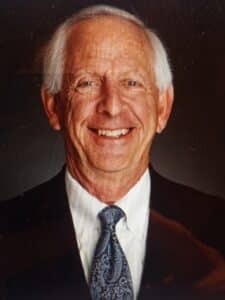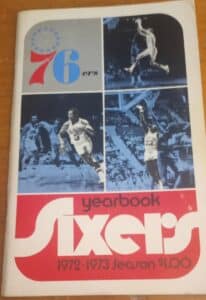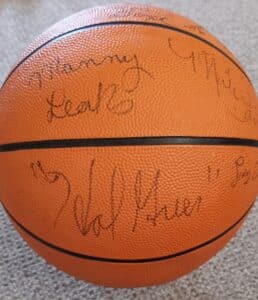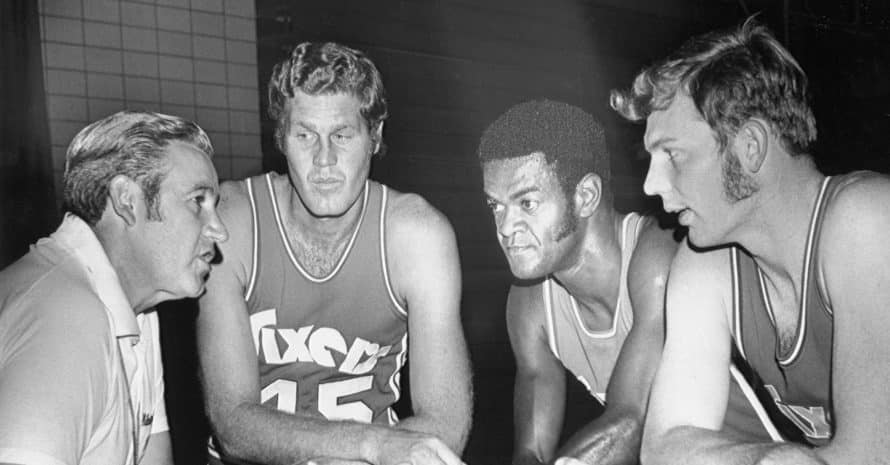LISTEN UP: Philadelphia 76ers head coach Roy Rubin, from left, instructs players John Block, Hal Greer and Gary Gregor during training camp in September 1972. (Getty Images)
Dolich’s first sports job marketing 9-73 team
Veteran sports executive Andy Dolich has taken his Facebook followers on a stroll down memory lane, sharing his thoughts and images of memorabilia he owns to recognize an NBA team that 50 years ago spent the season on a rocky road toward infamy.
The Philadelphia 76ers set a record for futility in pro basketball when the team concluded the 1972-73 season with a 9-73 record, which still stands today. At the time, Dolich served as administrative assistant to Sixers general manager Don DeJardin. It was Dolich’s first job out of college, launching a successful career spanning 40 years across the NBA, Major League Baseball, the NFL, NHL and professional lacrosse, before he became a college instructor and a consultant in the Bay Area, where he lives now.
Over those four decades, Dolich saw his teams win plenty of games. As a vice president with the Oakland A’s for 14 years, Dolich won a championship ring after the A’s beat the San Francisco Giants in the 1989 World Series. Yet, he holds a soft spot in his heart for the Sixers of loser’s lore, because that’s where it all started for him. He spent four years with Philly (1971-74) before taking a job with the National Lacrosse League’s Maryland Arrows.

Andy Dolich
“As I’ve gone down this path (of honoring the Sixers), people have said, ‘What are you doing, why are you wasting your time?’” Dolich said. “I tell them, because it was the first step of a career that I can only marvel at.”
It all started when Dolich was a student at Ohio University, among the first schools in the country to offer a sports management program. DeJardin visited the Athens, Ohio campus, searching for interns to help sell Sixers season tickets. In the early 1970s, Ohio students had to serve a six-month internship before completing their degree. Dolich, originally from Long Island, New York, and three other OU students signed up with the NBA club.
“I was lucky, because my older brother lived in south Jersey, so I bunked in the basement, came to work early and stayed late,” he said. “I ran to chaos and disaster as fast as I could.”
In those days, big league teams across the board had a small number of front office personnel compared with today’s sophisticated world of running sports business enterprises at the highest level. That was true in the NBA, and especially in Philly, which didn’t have the manpower of the Boston Celtics and the New York Knicks, which at the time were the class of the NBA, Dolich said.
As a result, the Sixers’ front office staff of about a dozen people completed multiple tasks regardless of job title. Dolich’s position as administrative assistant may sound a bit obscure, but his primary job, and that of most folks on staff, was to sell season tickets for the Sixers, a tenant in the old Spectrum, which at the time was still relatively a new arena after it opened in 1967.
“Those were the days when you could literally walk into any office building and try to sell tickets,” he said. “You didn’t have to worry about security, walking through metal detectors and emptying your pockets.”
In a short period of time, the other three OU interns decided to do something else and left the Sixers. Dolich stuck with the team, in part because he was living close to the Spectrum. Apart from selling tickets, among other duties, Dolich shuttled players to and from the airport and worked at the team’s training camps prior to the season.

MEMORIES: The Philadelphia 76ers 1972-73 yearbook (Courtesy Andy Dolich)
“What I remember was, holy cow, I’m working in the NBA,” he said. “The Spectrum was viewed as a quality venue and we had the Flyers, known as the Broad Street Bullies, who were doing great. The Phillies were across the street (at Veterans Stadium), plus JFK Stadium, where the Eagles played, and the Army-Navy games held there. To me, it was a dream come true before we played our first game.”
The dream turned into a nightmare on the hardwood after the Sixers started the season 0-15. Just five years earlier, the team had won the NBA title after going 68-13 in the regular season with star players Wilt Chamberlain, Luke Jackson, Billy Cunningham, Chet Walker and Hal Greer, who was also a member of the 1972-73 club.
“There was nobody really left except for Hal Greer,” Dolich said. “That season, we played four games in Hershey, Pennsylvania and four games in Pittsburgh. The team had started to go downhill, but it hadn’t gone all the way downhill until that year. I don’t remember all of it, but I’m sure that it came from the idea of maybe taking the team on the road (for some home games) and get them out of Philly.”
For those games elsewhere in-state, Dolich would grab a few buddies and load up his car with Sixers merchandise to sell at the old Pittsburgh Civic Arena and Hersheypark Arena, the same venue where Chamberlain scored an NBA record 100 points in 1962, and which still stands today.
Working with Mitchell & Ness, which at the time was just a local sporting goods company, Dolich had a hand in designing the Sixers’ famous block logo, which they still wear on their jersey today for some home games. Along the way, he came up with a series of giveaways with team branded T-shirts, shorts, socks, a gym bag and a rubber basketball. Collectively, they made up the “Uniform of the Year,” a promotional campaign that Dolich took with him to other teams in future years.

SIGN OF TIMES: A basketball signed by the 76ers of 1972-73, including Manny Leaks and Hal Greer. (Courtesy Andy Dolich)
“As a sports fan, teams would give away stuff like a poster that would end up in the garbage in a short period of time,” he said. “What is that going to do?”
“We thought about doing promos to attract kids under 14,” Dolich said. “We would do that on the games we knew that would draw well, such as the Celtics and the Knicks, that would get us to a sellout with more people than if we just did a boring game on a bad night of the week against (another) team that was not good. When you think about it, young kids, they’re not always into studying the team’s record and all that, but they like the experience and they got something free and they’ll wear it. We were trying to build an audience with families.”
Four years after that fateful season, after Dolich was gone, the Sixers turned things around on the court, due in large part to Julius Erving and George McGinnis coming to Philly after the NBA merged with the old ABA in 1976. Both had played in the red, white and blue ball league. The Sixers would go on to win the NBA championship in 1983, driven by Dr. J’s talents.
“If you were to do a graph of the Sixers, going from 1967 to 1977, it would be an amazing wave chart, at the top of and the bottom of the ocean,” Dolich said.







